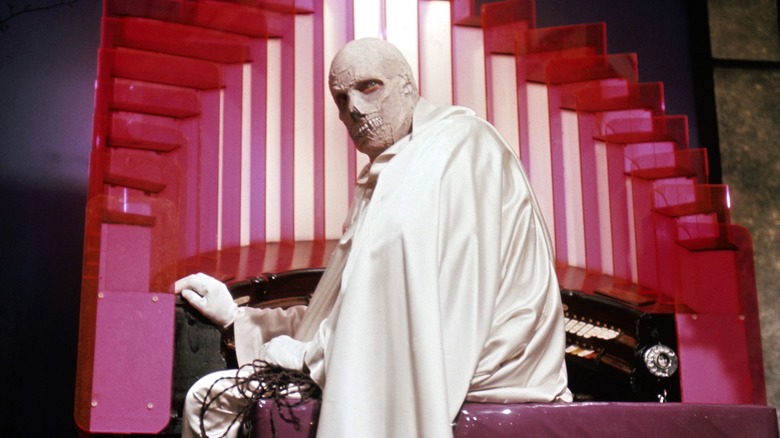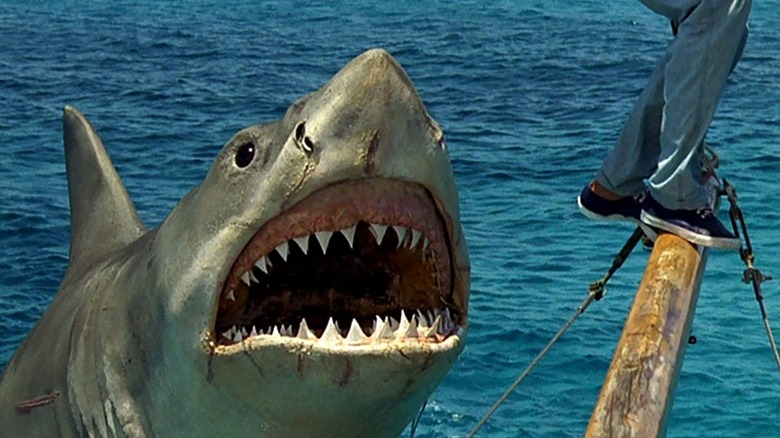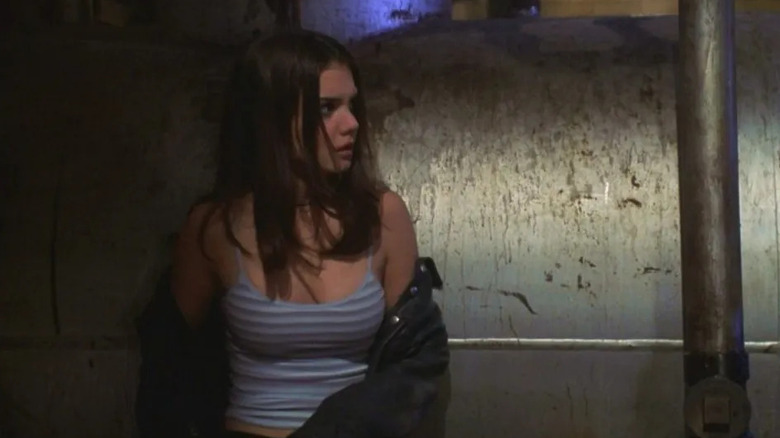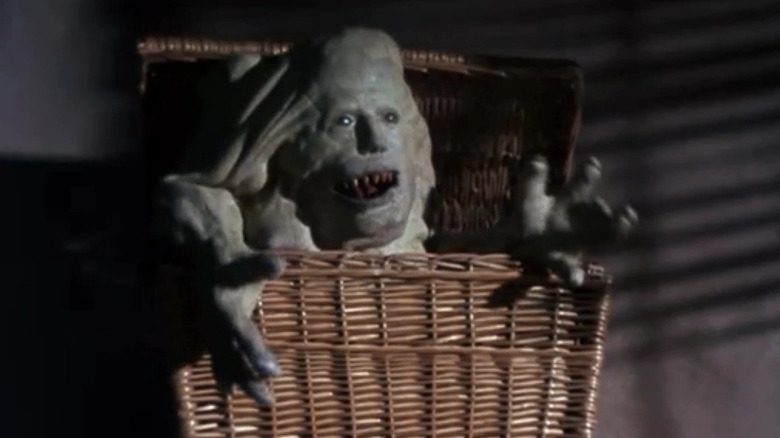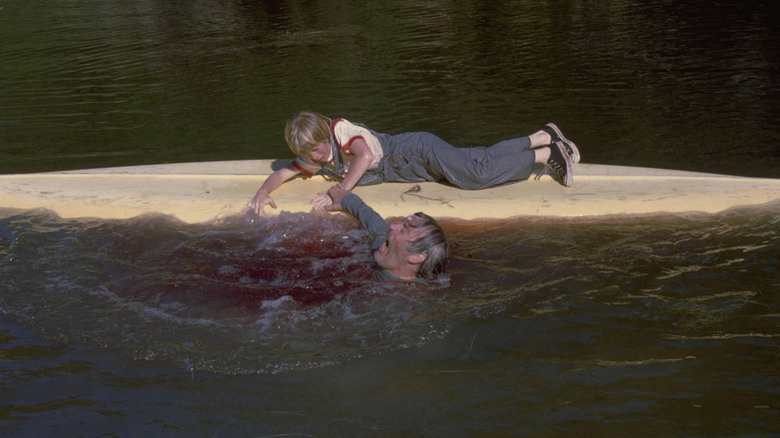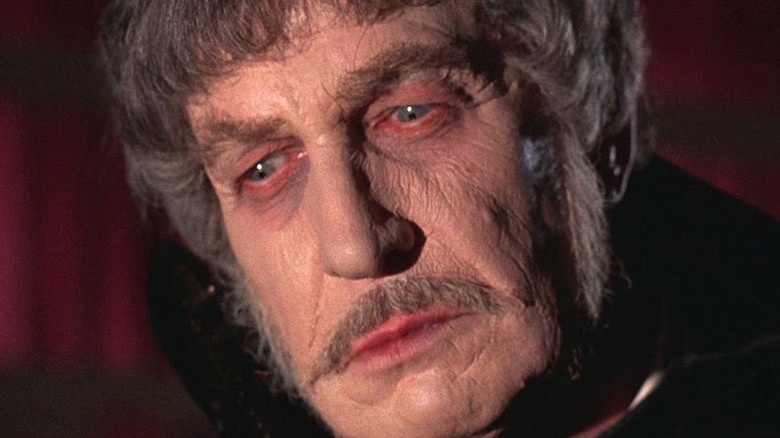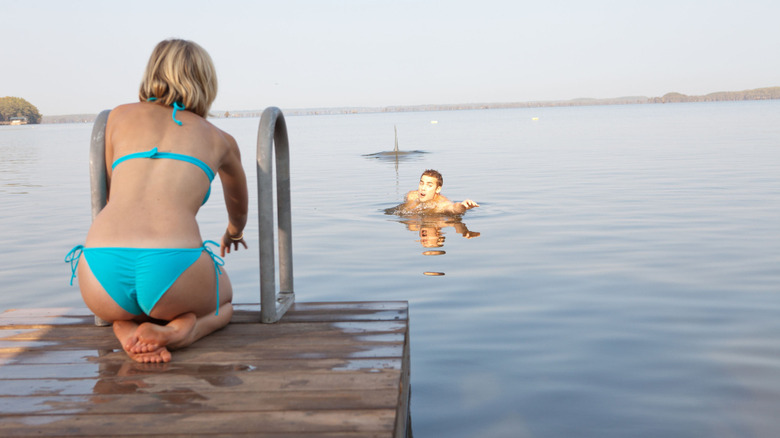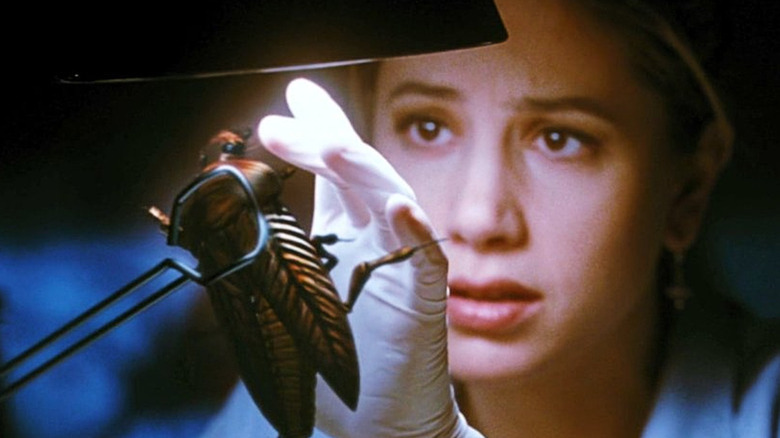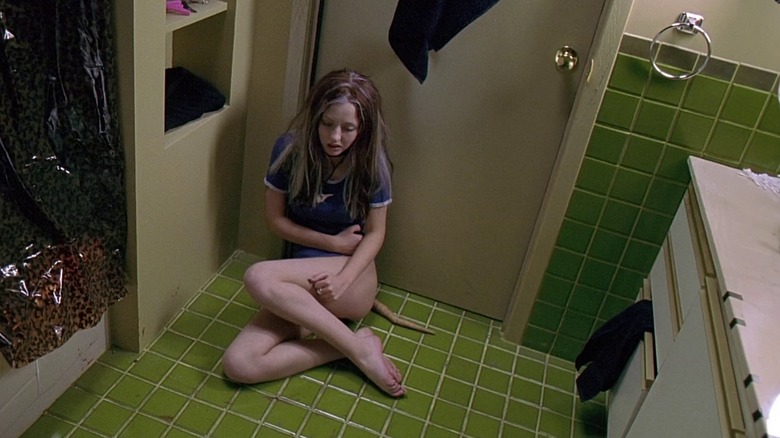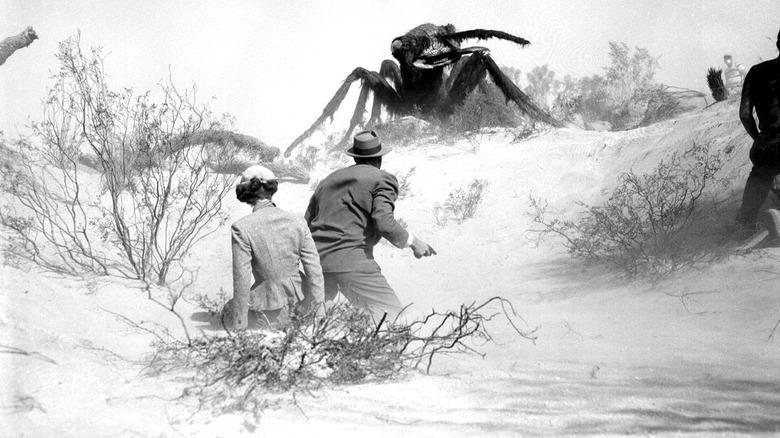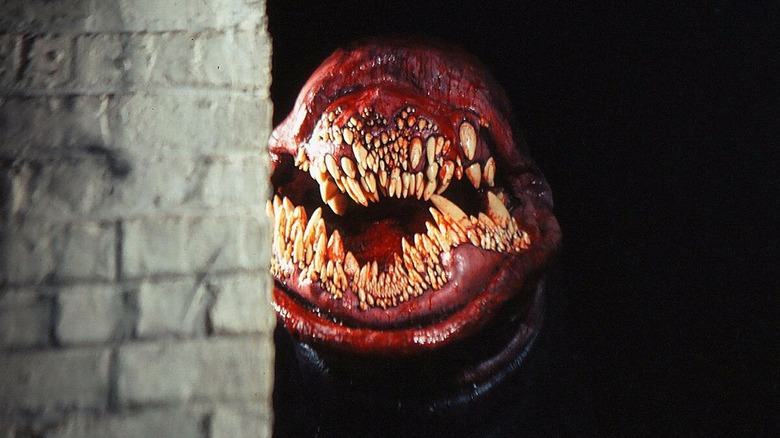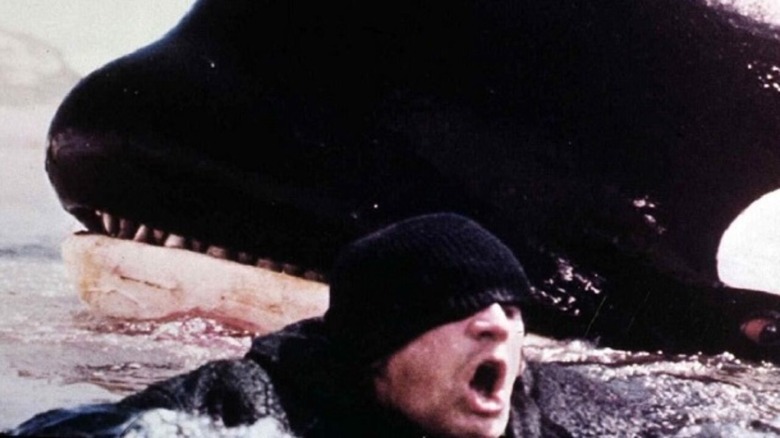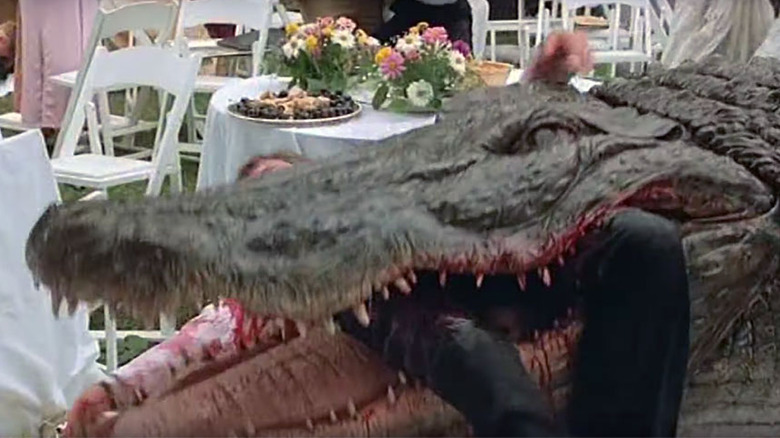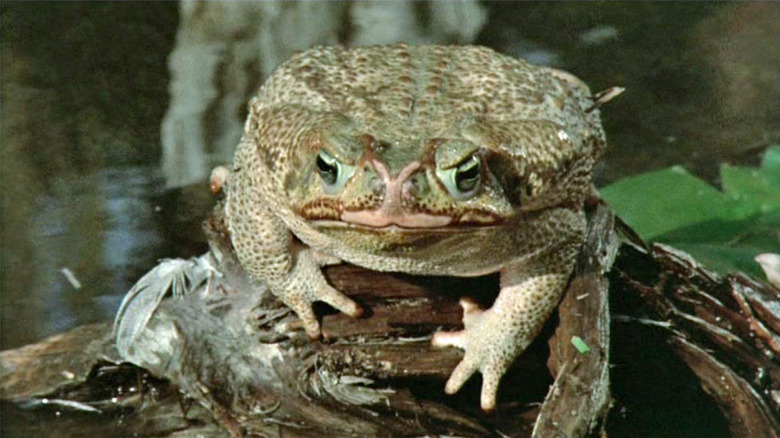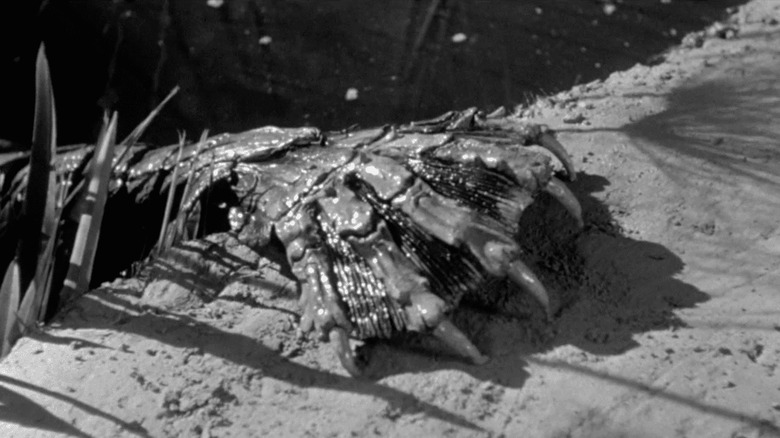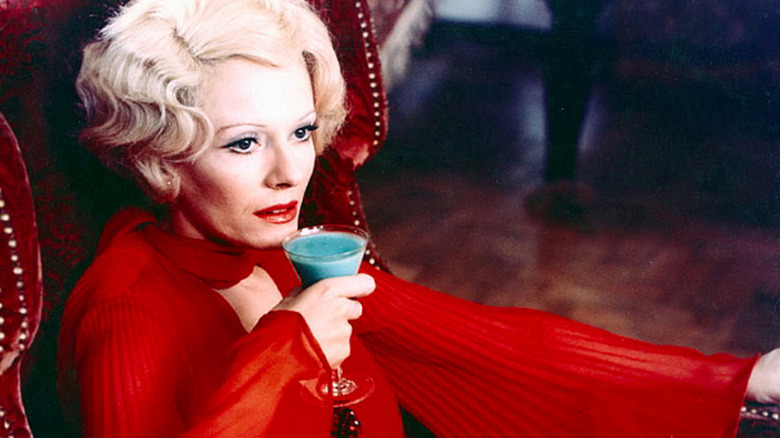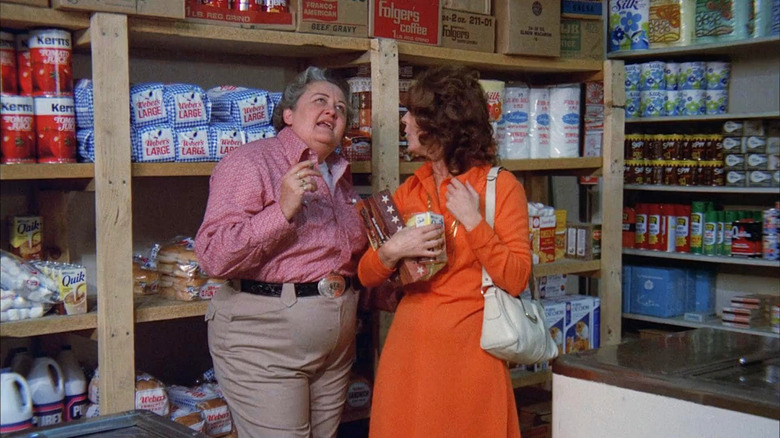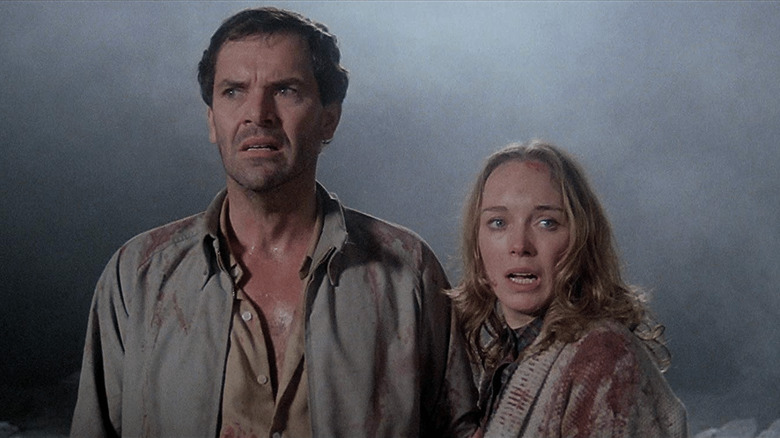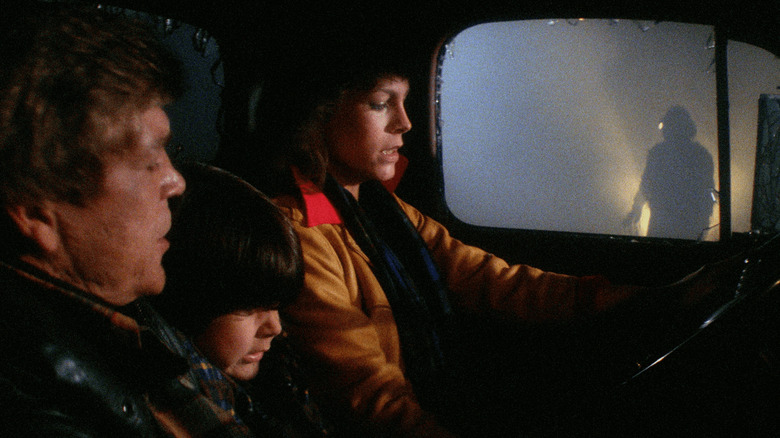18 Underrated Monster Movies You Need To See
Creature features have an unrivaled ability to straddle genres, often combining the best of thrills and frights, science fiction, and black comedy, sometimes inadvertently. Some succeed better than others. Weak scripts, shoddy effects, and monsters who don't deliver on scares are all components that separate the best monster movies from the other guys. Luckily, with the right combination of cheesy dialogue and wonky technical effects, you can accidentally stumble upon some of the best the genre offers. A shark hellbent on revenge? Check. Deadly slugs? Yeah, I guess. Murder turtles? Okay, sure. Often, the more ridiculous the logline, the bigger the payoff.
Films like "Jaws" and "Alien" introduced the standard for a monster movie: compelling characters, driving action, and some legitimately frightening foes. They inspired a gaggle of repeat offenders and exploiters. Bad shark movies are still being made, unable to understand how "Jaws" did it. Today, we're doing a deep dive into the 18 most underrated monster movies you need to see because bad creature features deserve some love, too!
Jaws: The Revenge (1987)
As a child of Blockbuster, I would stare at the VHS' of the "Jaws" movies, salivating with love for the franchise. Of all the covers, Part 4 was the scariest to me. It looked as though Mrs. Brody would face off against the shark on a sailboat. Okay, let's do this. It wasn't until I was an adult that I came to appreciate the lunacy of the plot: a shark — who might or might not have known the sharks from parts one to three — travels south to seek his revenge. Ellen Brody (Lorraine Gary, reprising her role from one and two) senses the shark whenever he is near, despite never facing off against a single shark in the first two installments.
It is '80s camp in every way, and I'm here for it. The shark effects rival "Jaws 3-D," not only because they're terrible, but because they look unfinished. No one should look at a shark in a horror movie and think, "Okay but give him another coat of paint!" During the film's climax, Ellen steals a boat to hunt the shark. It is one of the worst final showdowns in movie history, as Ellen experiences flashbacks to the end of the first film, despite not being present when Chief Brody destroys the first shark. There are notoriously two endings to this film, but neither of them answers our central question: "Is the shark really seeking revenge?" Bonus points for a guest appearance by Michael Caine as a lovably degenerate gambler!
Disturbing Behavior (1998)
In the world of "Scream" and "I Know What You Did Last Summer," it's easy for the science fiction horror film "Disturbing Behavior" to get lost in the shuffle. The film stars heartthrobs James Marsden and Katie Holmes, existing in a hybrid film that combines elements of "Invasion of the Body Snatchers" and "The Stepford Wives." Sometimes it can feel like a standalone episode of "Buffy the Vampire Slayer," but it works as a film if you already have a love for its Kevin Williamson-penned contemporaries. This is the movie you put on after you've watched "The Faculty."
"Disturbing Behavior" touches on themes of assimilation versus individuality, grief, and morality. The political divide between the outcasts and the preppy kids is as simple as it is poignant. The preppy kids are all part of an after-school program called the Blue Ribbons, billed as a motivational, charitable, and character-building after-school club. Of course, their real goal is control and assimilation, turning everyone in their quaint little town into mindless pod people. These types of relationships exist in our world today, and sometimes I find the scariest evil to be the one that presents itself with a smile and a hug.
Basket Case (1982)
I don't understand why this movie was made, but I love it. Set in the gritty, pre-Disney Times Square of yesterday, Duane Bradley arrives in New York City with a strange wicker basket, looking for a room to rent. He finds the seediest hotel in Times Square to call home. It turns out his twin brother lives in the basket: a demon-like, disfigured creature that is powerful despite his small stature. His name is Belial, and his two favorite things are hamburgers and revenge. Love that for you, Belial. Duane is only an accessory to this revenge film; it's his brother, Belial, who wants to murder all the doctors that separated the previously conjoined twins.
While I'm in full support of a silly revenge plot, "Basket Case" gets distracted easily, and we also have a romance subplot between Duane and Sharon, an administrative assistant. Then we meet some strange characters living in the hotel with Duane, including sex worker Casey. I love the supporting characters in this film, but they almost don't belong, which is to say: either cut them entirely or give them the screen time they deserve. I would have liked Casey to be more involved in uncovering the revenge plot. Still, this totally ridiculous film forces me to ask, "Can a wicker basket be scary?"
Piranha (1978)
This 1978 flick opens with two hot young people breaking into a private facility because it has ... a pool. Swimming at night is something people love to do in horror movies, but I've never understood it, probably because I watch horror movies. Once in the pool, our lovable teens are eaten to death by an unknown assailant. And so sets the tone for "Piranha," a film that wants you to know from the jump that in structure, at least, it will be capitalizing on the success of "Jaws." It's a delightfully terrifying film, even if it borders on black comedy rather than traditional horror. As vicious as piranha may be, they're still tiny, baby-like fish. It's hard to treat them with the same shock and awe that one might reserve for a 30-foot Great White.
"Piranha" also dances around the summer camp slasher genre (even though it predates "Friday the 13th"). Our school of piranha travels up a lake and torments all the campers they can get their fangs on. "Piranha" teaches us that filmgoers want to see people murdered on vacation. What makes this film underrated is its comedy, intentional or not. The humor prevents it from being taken as seriously as other monster epics, but that doesn't take away the fun you can experience when you watch.
The Abominable Dr. Phibes (1971)
"The Abominable Dr. Phibes" is my favorite Vincent Price movie. Price plays Dr. Anton Phibes, a scarred zombie-like concert organist who mourns the loss of his wife by seeking revenge on the doctors he holds responsible for her failed surgery. To give his murders a creative flair, Phibes draws from the Ten Plagues of Egypt, which means yes, there will be locusts. He treats murder like set pieces, which adds a welcome element of theatricality to the film. The scares are a slow build. You don't expect to see Phibes in the closet with a knife; he's too sophisticated for that. Instead, he arrives early at the future crime scene, sets up his murder, then watches from the sidelines — the ultimate voyeur.
With a supporting cast including Joseph Cotten and Terry-Thomas, "The Abominable Dr. Phibes" blends camp, dark humor, and some genuine scares to create the ultimate standard for a midnight movie. Because of the revenge structure, the film works as a series of vignettes rather than a traditional narrative. Sure, Scotland Yard is "on the case," but really, their scenes are just included to give us a breather in between murders.
Instead of a final girl, we spend most of our time living in Phibes' point of view. It's one of the only monster movies I can think of where our killer is also the main character. His love for his dead wife also creates an emotional connection between Phibes and the audience, which makes him a nontraditional baddie. Am I rooting for Dr. Phibes? Yes, I think I am.
Shark Night (2011)
The single greatest deterrent to enjoying a shark film is lousy CGI unless the premise of said film is so ridiculous that bad CGI is on brand. (Think "Sharks of the Corn" or "Santa Jaws.") With "Shark Night," we have a legitimate attempt to make a compelling shark thriller that blends elements of "Jaws" with "The O.C." Despite a solid effort, the film fails to make the sharks look scary. I have to offer some grace, as the film was made 11 years ago. Shark movies have never cracked the code on "Jaws," but this movie distinguishes itself by creating an absurd subplot involving human villains that ensures it is both entertaining and preposterous.
Sheriff Sabin (Donal Logue) leads our gang of Shark Week-obsessed villains who feed innocent people to sharks so they can record the bloodshed, which works in a fun parallel to 2011's "Scream 4." What I liked about both "Scream 4" and "Shark Night" is their ability to speak on the toxicity of fame and how being obsessed with a movie or a T.V. marathon can have deadly consequences. It begs the question: How long before a fame-crazed internet troll becomes a murderer? It's only a matter of time before the Annie Wilkes of this world rise up. In this case, it would be a "Jaws" stan who sets about making a real-life requel. "Shark Night" is due for a sequel to capitalize on the TikTok generation.
Mimic (1997)
At the start of quarantine, many brave souls turned to disaster films like "Outbreak" or "Contagion," while some of us hid under a pillow with "Brigadoon" playing on a loop. While quarantine movies might still be "too soon" for some viewers, I stumbled upon the pandemic-adjacent film "Mimic" and enjoyed it more than I anticipated. Partly because Mira Sorvino serves as our Final Girl, Dr. Tyler, and this film shares the same composer as "Scream" (Marco Beltrami) and uses the same score from the Ghostface epic.
In New York City, cockroaches are spreading a novel virus that targets the city's children. To stop the spread of this disease, Dr. Tyler engineers a hybrid bug, part-mantis and part-termite, known as the Judas breed. Although this Judas eradicates the cockroach population, its genetically engineered strength allows it to grow in the subway system and eventually wreak a different sort of mayhem on New York City.
This movie is not for the squeamish. We have giant, scary bugs and the NYC subway system. The ick factor is real. What I love about this movie is that it's basically a sequel. Dr. Tyler saved the city from a debilitating disease, only to learn that her efforts have created a different monster underneath the city. It's that type of dramatic irony that you don't often see in creature features, which is why it shines on our most-underrated list.
Ginger Snaps (2000)
The teen genre often overlaps with horror seamlessly, which is why "Scream" is as good of a teen coming-of-age story as it is a great slasher. Then you have horror cousins, movies like "Heathers" and "Jawbreaker," which stay more in the teen-comedy lane but have a body count. Some great horror cousins get lost in the crowd, though, among them 2000's "Ginger Snaps." This movie is basically "Heathers" meets "The Wolf Man." When I first watched it, I was shocked it took me until 2020 to discover it. "Why aren't more people talking about this movie?" I said to a friend. Sure, it has had a sequel and a prequel, but "Ginger Snaps" doesn't get the recognition it deserves.
Katharine Isabelle (who also appears in "Freddy vs. Jason") stars as Ginger Fitzgerald, who, along with her sister Brigitte (Emily Perkins), are the outcasts of their small, spooky town. While vampire narratives often double as queer stories, we don't always get to see that with a werewolf story. Is Ginger's transformation a commentary on coming out? An expression of her outsider status or her newfound womanhood? The movie succeeds because you can interpret it in many different ways. It's a B-movie with an A message, but it's up to savvy viewers to answer those questions for themselves.
Them! (1954)
This monster mash reflects the societal fears of the mid-20th century. The threat of nuclear attack pervaded all walks of life, and with "Them!" we learn what the world would look like if radioactive ants threatened civilization. I think the special effects are so impressive, especially when you compare them to the CGI tomfoolery we as viewers were subjected to in the early 2000s. What makes this film underrated? While the threat of nuclear attack may still exist today, it is not met with the fervor it was in the '50s.
Additionally, the monsters in this film are still ants. They're big ants, yes, but they're ants. Their behavior is not outwardly nefarious. They are, literally, just acting like ants. The title also has the potential to push this film into ambiguity. All these things combined mean that "Them!" might be an endangered species to cinema if we don't give it the appreciation it deserves, passing it down to the next generation of moviegoers who will never look at an ant hill the same way again. The film also works as a political commentary because in "Them," bullets tend to precede critical thinking.
The Deadly Spawn (1983)
"The Deadly Spawn" is one of the worst constructed movies I have ever seen, and that's part of the reason why I love it. The premise boils down to a meteor crash landing on Earth and bringing with it deadly aliens from outer space. Are these aliens frightening? Menacing? No, and not really. They're slugs, space slugs. Through logic left unexplained to this viewer, our space baddies end up in the basement of a family of four, including two boys: Peter, who wants to be a scientist, and Charles, who loves horror movies. That combo is pretty much the perfect setup for an alien creature feature.
This movie feels like it was made on a budget of $20. It suffers from awkward editing, whereby it feels as though the actors take a three-second pause between each person's line, giving the entire movie a sluggish quality (pun absolutely intended). What makes this movie enjoyable is how funny the slugs are. They look like little fingers and are, ultimately, deadlier than they should be because no one reacts quickly enough to their mischief. A particularly gruesome massacre occurs at a vegetarian potluck.
Side note: This movie portrays vegetarianism as the wildest and most unusual concept. The vegetarians accidentally eat some of our slugs before the rest of the creatures devour them for lunch. It is an imperfect B-movie that nonetheless oozes adoration for the genre. While it might not rank among the best monster movies, it never ceases to entertain.
Orca (1977)
"Orca" is so over-the-top it's hard to believe it's real. Besides the grand music score (brilliantly composed by Ennio Morricone), the Quint-like-understudy — and a duel on ice between a man and a whale — this obvious attempt to copy the success of "Jaws" was not appreciated as its own film when first released. It manages to copy "Jaws," make fun of it, then reassemble the narrative to make its own film that borders on harrowing in the last act. My advice is to watch this understated gem immediately followed by the SeaWorld documentary "Blackfish."
Miserly Captain Nolan (Richard Harris) hunts for an orca after he watches one destroy a great white shark in a scene that screams, "See! Orcas are scarier than sharks!" Unfortunately, Nolan catches a pregnant female whale, upsetting the dude whale watching from just beneath the surface. To avenge the death of his wife and unborn whale baby, our alleged antagonist whale causes chaos on the small fishing village where Nolan and his crew reside.
"Jaws" never made me feel pathos for the shark, but "Orca" is so emotionally top-heavy that I find myself not just rooting for this whale but crying over his losses. The whale's revenge is more creative than anything a shark has done in "Jaws," which adds a deep level of chills to this aquatic feature. There is a particularly gruesome scene with Bo Derek's character that simultaneously homages Quint's demise while still advancing what a sea attack can look like.
Alligator (1980)
Unlike some of the "Jaws" exploitation flicks on this list, "Alligator" was in on the joke. While "Orca" found power in an emotionally jarring narrative, "Alligator" takes a bite out of black comedy. This monster film, based on the urban legend of flushing alligators down the toilet, thrives as it blends comedy with frights to make a film that is captivating, scary, and fun.
"Alligator" has everything: a Brody-like protagonist, corrupt city officials, evil corporations, and a nearly 40-foot monster chilling in the sewers. The creature is the most terrifying when people come upon him accidentally in the sewers. I love these moments of real scares because they balance out the humor we encounter later on in this film.
One thing about our alligator foe is that he loves pools and weddings. When the alligator crashes an affluent wedding and feasts on the guests, I couldn't stop laughing. An added irony of this film is that the alligator only grew to such a size because of human greed and corruption. So as much as I shouldn't be rooting for the alligator to eat his way through this town, I'm not upset when he makes a buffet of the 1%.
Frogs (1972)
Ray Milland is one of the greatest actors of our generation, famous for dazzling audiences with his Academy Award-winning performance in "The Lost Weekend" and his diabolical turn in Alfred Hitchcock's "Dial M for Murder." Yet it is his role as the Tennessee Williams-inspired patriarch in "Frogs" that is the most memorable of Milland's career. While actresses like Bette Davis and Joan Crawford were carving out third-act careers with a sub-genre of horror called "hagsploitation," the men were doing it, too; they just weren't labeled "hags" in the process.
In "Frogs," Jason Crockett (Milland) hosts his greedy family members on his little island, located amidst a swamp-wildlife wonderland. The supporting cast is brassy and entitled, concerned only about their inheritance, which is what makes this movie feel so much like "Cat on a Hot Tin Roof." Crockett has contributed to pollution on the island, but it's his birthday, so he doesn't really care. The wildlife, however, does. Frogs, snakes, tarantulas, and even turtles seek their ecological revenge on the Crockett clan.
The turtle attack is one of my favorite scenes in all of cinema. It's one of those moments you can rewind 10 or 15 times in a single sitting. It's so bad it's brilliant. As a first-time viewer, I didn't understand the commentary on wealth, but watching it today with its subtle message of eating the rich, I enjoyed it a lot more, and I hope you do, too.
Creature from the Black Lagoon (1954)
How can one of the original Universal Monsters be considered underrated? Here's the thing: I always see the Creature (aka "The Gill-man") featured on the cover of anthology box sets, posters, and even novelty cups. But he only ever got two sequels. The Creature feels like the most neglected monster from the original batch of Universal baddies. Where are the remakes or TV adaptations? Is this the least-remade film from the O.G. monster years? This author thinks so.
"Creature from the Black Lagoon" follows an expedition to the Amazon where a group of scientists comes face to face with the titular Creature. What I like about the Creature is that his initial kills are in self-defense. It's man's unwillingness to understand other species and to instead lead with violence that fuels this plot. The Creature is sensitive, inquisitive, and emotionally intelligent in a way you may not expect.
This movie stands out from "Dracula" or "Frankenstein" for three reasons: its villain isn't really a villain, it departs from the standard castle-in-a-wooded area for a tropical location, and it's easy to develop an emotional connection to the Creature. Perhaps the reason why there weren't as many adaptations in the years since is that the Creature really is one of the good guys.
Daughters of Darkness (1971)
Dracula gets to have all the fun. This author believes him to be the most famous graduate of the Universal Monsters University of Terror, which is why I'm always rooting for other vampire narratives to get a chance. "Dracula's Daughter" was a pioneer for both female-driven and queer narratives, but it wasn't until 1971's erotic horror "Daughters of Darkness" that we got to see sapphic demons thrive.
Set in the nearly empty hotel in a seaside village, "Daughters of Darkness" follows Countess Elizabeth Bathory (played by the phenomenal Delphine Seyrig) as she pursues her next lover. The Countess is looking for a romantic partner who also doubles as her Renfield. She finds her next great love in newly married Valerie. Her husband and the Countess' current lover round out the cast in this sensual battle for power.
For the first 20 minutes, I wondered if I had stumbled onto a blue movie, but this film leans more toward horror than porn. "Daughters of Darkness" immerses the viewer in atmosphere and Hawthorne-esque symbolism (the color red features prominently throughout). It's a feeling as much as it's a tangible narrative, which makes for a thrilling viewing experience. Its queer themes only speak to the universality of desire, and that's something everyone can enjoy.
Fangs (1974)
Shudder is home to some of the greatest B-movies available, and "Fangs" did not disappoint my spooky desire to watch a scary movie at 3 a.m. You can tell this movie is underrated because it doesn't even have an entry on Wikipedia. Les Tremayne stars as Snakey Bender, who uses snakes to kill all his neighbors and friends. We love a revenge plot.
"Fangs" has elements of "Frogs," "The Abominable Dr. Phibes," and "Basket Case." What's important to note is that the snakes are not the villain. Once again, we have found ourselves face-to-face with the dark underbelly of human behavior. Snakey is pitiable more than he's scary, which does cast a layer of sadness over this film. His friends don't betray him so much as they move on with their lives, and Snakey can't handle that.
What I like about this masterclass in what a B-movie can be, though, is the characters are quickly defined and developed, the kills are creative and fun, and the atmosphere succeeds in painting an abandoned town in the middle of nowhere. The low-budget production makes it feel — at times — like "The Texas Chain Saw Massacre" or "Eaten Alive."
The Beyond (1981)
I have seen this film close to 100 times, and I still feel like I don't know what it's all about. While cinephiles might disagree with me calling this film underrated, I don't believe it has broken through the mainstream mold in ways it deserves. Directed by Lucio Fulci — who boasts "Zombie" and "The House by the Cemetery" among his credits — "The Beyond" explores the supernatural happenings at a haunted hotel in New Orleans.
This movie is disorienting, and the brilliant musical score (composed by Fabio Frizzi) only adds to the sense of madness the viewer feels as they watch. Are there zombies? Do we travel to a different planet or realm? That's Hell, right? These are common questions I still find myself asking when I rewatch "The Beyond." The short answer is it doesn't really matter. The film is an atmospheric ride of scares that extends long after you finish watching.
The final moments pulsate with fear and tension as our protagonists find themselves dropped into the scariest place on Earth. The bad dubbing, weak script, and plot inconsistencies are the defining qualities that make it underrated versus a horror classic. But its shortcomings only add to the film's mood, so it's not exactly a bad thing.
The Fog (1980)
I devote a lot of my life to getting people to watch this movie. When I encounter fans of "Halloween" or "Creepshow" who haven't seen John Carpenter's "The Fog," I am stunned. This movie is not instantly adored by people who love "Halloween" or the slashers it inspired, even though the cast overlaps in ways we might associate with Mike Flanagan today. It's a simple ghost story that is more about gentle chills than agonizing tension and jump scares.
Featuring a stacked cast including Jamie Lee Curtis, Nancy Loomis, Janet Leigh, and Adrienne Barbeau, "The Fog" follows the inhabitants of a seaside village as they plan to celebrate their 100th anniversary. Most of the characters don't interact with each other until the final moments, as they're all on separate journeys: searching for missing fishermen, investigating a mysterious sign washed ashore, and discovering the deadly truth surrounding the town's founding fathers.
"The Fog" features one of Carpenter's best scores as well as one of my favorite chase scenes of all time, where Stevie Wayne (Barbeau) battles the fog alone atop her lighthouse — the only main character to fight solo — as the zombie-ghosts within try to kill her.
